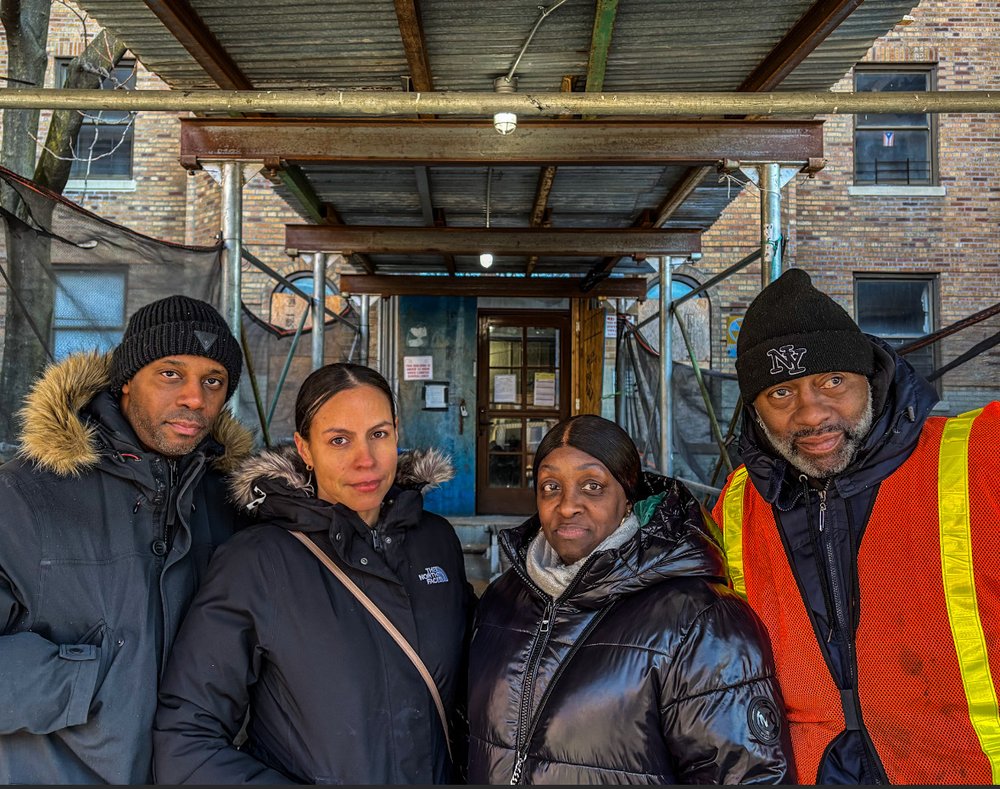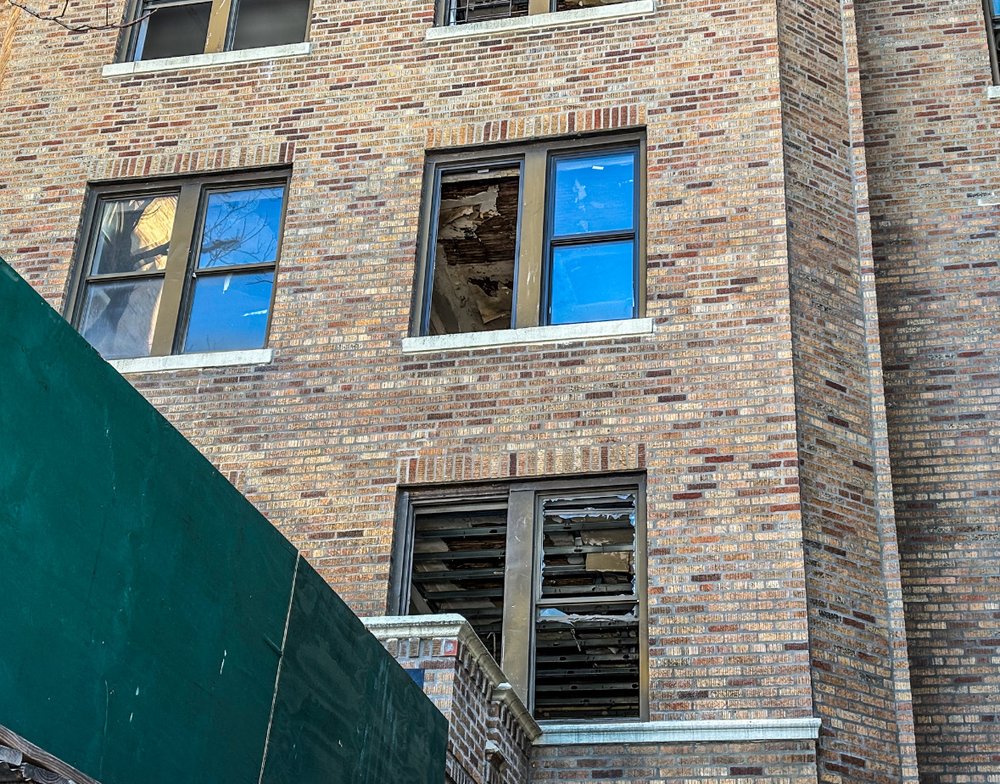After fire, a years-long wait to return home in New York City
Jan. 28, 2025, 6 a.m.
Tenants in a Bronx apartment damaged by fire have been waiting 19 months to return home — a chronic problem for renters made homeless by disaster.

A spate of fires has ravaged New York City apartment buildings this winter, casting hundreds of residents into homelessness overnight. Less than three weeks ago, a six-story apartment complex on Wallace Avenue in the Bronx was engulfed in flames sparked by faulty electrical wiring, forcing more than 200 people to leave their homes. A pair of overnight blazes in Manhattan killed one person and left several others injured in December.
New Yorkers who've had their lives upended by fire can face a lengthy, often years-long wait to move back home with no clear timeline for their return. Monthly data from the city’s Department of Housing Preservation and Development show at least 2,210 people were staying in shelters for tenants displaced by disaster or dangerous living conditions in November 2024. And many residents, attorneys and construction experts said the process for getting tenants back in their homes is plagued by bureaucratic obstacles, insurance delays and property owners who neglect to complete the work or drag their feet.
Many turn to spartan shelters operated by the city’s housing agency, squeeze in with friends and family, or search for another place they can afford. Families with children stay in HPD-run shelters for an average of nearly 9.5 months after a fire or other disaster, while single men stay for nearly 20 months on average, according to the statistics.
For the tenants of 1420 Noble Ave. near the Cross Bronx Expressway, their wait has now stretched into 19 months of uncertainty. Dozens of apartments in the 79-unit building were destroyed by a fire and water from the sprinkler system in June 2023, displacing everyone who lived there.
In the wake of the blaze, 41 tenants sued the landlord to speed up the repair work and address a raft of other violations that predated the fire. HPD filed its own lawsuit over the pace of renovations and the pre-existing violations for leaks, heat outages and vermin.
The building’s owner, Ved Parkash, has so far failed to meet court-ordered deadlines to complete the work and tenants said their situation fits a pattern with other Parkash-owned buildings. Three of his Bronx buildings have burned over the past two years, including the blaze on Wallace Avenue in Allerton, which displaced more than 200 tenants earlier this month, and another in June 2023, which killed two tenants. Parkash was listed as the city’s “worst landlord” by the public advocate in 2015. All three fires were sparked by faulty electrical wiring, the New York Times reported.
“I just wish that there was also a lot more focus on fire victims and people who've been displaced from their apartment buildings,” said Arlene Santiago, a fifth-floor tenant in the Noble Ave. building who was forced to leave the apartment she shared with her daughter and fiance. “Making sure that their buildings are renovated, that they're put back in immediately.”
'It’s hard to get the landlords to hustle'
In May of last year, a judge ordered Parkash and his management company to finish work on the building by October. Parkash missed the deadline, prompting the tenants to seek a contempt order from a judge that would result in daily fines and the threat of jail time.
Legal Aid Society lawyer Benjamin Seibel, who is representing the tenants, said Parkash is moving too slowly.
“It's hard to get the landlords to hustle up and get the building back into livable shape,” he said “Unfortunately, it is something we see over and over again.”

On Monday afternoon, lawyers from the Department of Housing Preservation and Development submitted an affidavit from an inspector who found the building was “not close to occupancy ready.”
The landlord, the inspector said, has "failed to show good faith effort that the fire-abatement work is getting done expeditiously to restore the tenants to their occupancy over 19 months after the fire."
But Parkash and his attorneys argued that the October deadline was unrealistic. In court papers, they told the judge that the company couldn’t begin extensive repair work, including installing a brand new roof, plumbing and electrical systems, until an insurance company approved an estimated $20 million in costs and contractors removed asbestos from the building. A contractor’s February 2024 assessment put the timeline at 16 months, according to another legal filing.
In a written statement, a spokesperson for Parkash Management said the company has tried to assist tenants and transferred some residents to other apartments in their portfolio. He said contractors have so far removed asbestos, replaced the roof and rewired the electricity in the building and are now working on the individual apartments. They said getting tenants back in their apartments makes smart business sense.
Pattern of delays
Raja Riasat, a contractor who specializes in restorations following fires, said he’s seen many similar projects slowed down by administrative delays. He recommended that city officials begin assigning examiners to work with owners on streamlining the renovation process and cutting through any bureaucratic hurdles that stand in the way of families returning to their homes.
“ I've always wished that the city would have a fast-track program for these types of issues,” Riasat said.
Buildings spokesperson Andrew Rudansky said the agency already has several programs in place to streamline renovations following a fire, including one-on-one guidance for property owners, permission to immediately begin emergency repair work and a shortened review process for additional work applications.
Rudansky said the strategies have “for years helped landlords immediately start repairs so that tenants can safely return to their homes as soon as possible.”
Peter Varsalona, a principal at the firm RAND Engineering & Architecture, attributed the lengthy process to a range of factors that can be complicated by slow-moving landlords.
“If it’s being held up, it’s usually a financial reason,” Varsalona said. “Usually the control of re-occupancy is with the owner and with their design and construction team.”
In Jackson Heights, tenants of a 133-unit apartment complex waited more than two years to move back home following a fire. Residents of a six-unit building in Sunset Park sued after their landlord reconfigured their apartments two years after a blaze that left them homeless.
A spokesperson for the city’s Department of Housing Preservation and Development said the agency does not track how many people become homeless specifically because of fire.
'Up in the air'
Today, many of the windows on the Noble Ave. building are missing or broken, exposing damaged walls and destroyed ceilings inside the apartments. Plywood sheathing covers the windows on either side of the entryway, which is blocked by mesh netting affixed to a long sidewalk shed. When a Gothamist reporter visited last week, no visible work was taking place on the building.

Renee Thompson Castro, a 62-year old security guard who lived in a one-bedroom apartment on the third floor of the Noble Ave. building, said she and her husband have been staying in a Harlem shelter since losing their home, with none of the conveniences of their former lives. She loves cooking, she said, but their shelter unit has no kitchen, forcing them to buy prepared meals. They also share a hallway bathroom with other shelter residents and face a longer commute to work and family. Her mother lives across the street from their home on Noble Ave.
“You can't live the way you want to live,” she said, adding that she is eager to return, but with no idea when that might be. “ We’re up in the air.”
Santiago, the fifth-floor tenant, said the wait has taken a toll on her family.
She works as an administrative law judge at the state’s Office of Temporary and Disability Assistance and has been staying with her 3-year-old daughter and fiance at a friend’s home while they await renovations. She said she and her family decided to live in their one-bedroom apartment on Noble Ave. because it was affordable at around $1,300 a month and located just three floors above her mother.
She said she used to encourage her mother to apply for apartments in buildings for seniors, but her mother refused to leave.
“She would tell me, ‘No, no, no. I want to stay here. Everybody I know is here,’” Santiago recalled.
After the fire, her mother eventually did move into a senior building, but she died in April, still wishing she could have returned home to Noble Ave., Santiago said.
“It just hurts that we couldn't fulfill that wish that I knew that she had,” Santiago said. “ This was her home.”
Can Midtown become the next FiDi? NYC looks to build housing in commercial district NYC falling short of Mayor Adams’ goal on federal rental assistance vouchers Dang, it’s cold! Here’s what to do if you don’t have heat in your apartment.